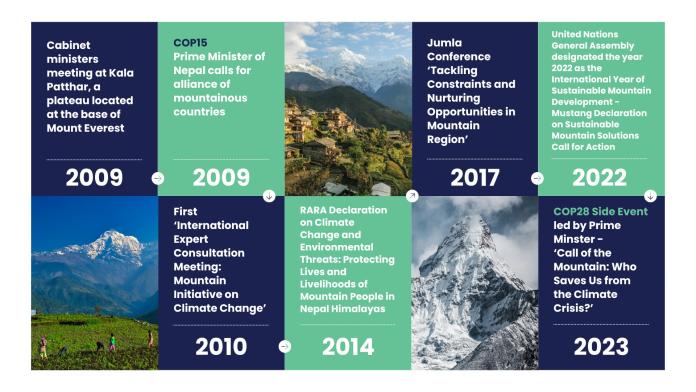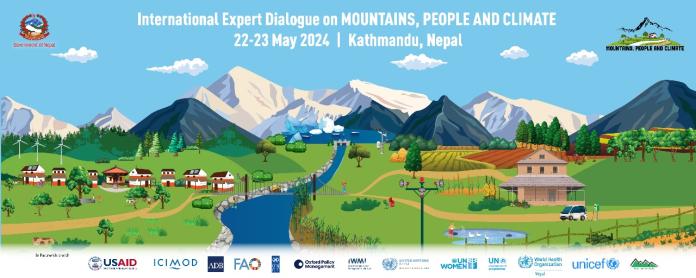Melting glaciers, rising urgency: Making mountains central to climate talks
With a third of Nepal's ice gone in 30 years, the Himalayas' rapid melting highlights why saving mountain regions is critical for global climate stability.
-
Date
May 2024
-
Area of expertiseClimate, Energy, and Nature
-
CountryNepal
-
KeywordsClimate change adaptation , Climate change mitigation , Climate policy and finance
-
OfficeOPM Nepal
The Himalayan glaciers are melting rapidly, with Nepal losing a third of its ice in just over 30 years. The latest science by the Intergovernmental Panel on Climate Change (IPCC) warns that temperature evolves faster in mountain regions - potentially impacting the population and ecosystem services that they provide. This alarming trend directly results from greenhouse gas emissions heating our planet.
Until now, mountain regions have been underrepresented in global discussions, but these vital areas should be the priority for international climate action. This week there is an International Expert Dialogue on Mountains, People and Climate in Kathmandu to strengthen, coordinate and prioritise mountain-based actions and encourage mountain countries and agencies to collaborate on UNFCCC mountain work and programmes. Recommendations from this conference will inform the expert dialogue on mountain and climate change agenda in the 60th Subsidiaries Bodies session of UNFCCC in Bonn, Germany in June, 2024.
Figure 1. Key highlights: Nepal on the mountain and climate change agenda

The vital role of mountain ecosystems
Mountains, high latitudes and the cryosphere are essential elements of the ecological balance of our planet in four main ways:
Water supply: Mountains act as water towers. They store water as snow and ice and slowly release it over time, nourishing rivers and groundwater.
Biodiversity: These regions are home to diverse flora and fauna, many of which are specially adapted to the current harsh conditions.
Climate regulation: The cryosphere plays an important role in the Earth's climate system. Snow and ice reflect sunlight back into space, helping to regulate the planet's temperature.
Carbon sequestration: These areas capture and store large amounts of carbon dioxide, thereby reducing greenhouse gases in the atmosphere.
Key priorities for safeguarding mountain regions
With climate change significantly impacting mountain regions, access to context-specific knowledge, technological innovations and financial resources is essential for countries to implement effective adaptation actions. We are supporting the efforts of the Government of Nepal to drive the mountain agenda in climate negotiations through the UK Government-funded Climate Ambition Support Alliance (CASA). In collaboration with leading climate experts, we present the following recommendations:
- Strengthen Science, Evidence and Knowledge: Generate reliable evidence of Climate change impact, vulnerability and risk in the mountains. Promote the use of indigenous knowledge.
- Minimise the Water Crisis: The glaciers could disappear altogether unless we change course. This would reduce flows for major Himalayan rivers like the Indus, Ganges, and Brahmaputra, affecting millions in South Asia.
- Improve Monitoring of Himalayan Glaciers: Reduce observational knowledge gaps, particularly in understanding cryosphere variables like permafrost extent, glacier ice volumes and snow cover variation. Compare past impacts and future risks across mountain regions.
- Strengthen the adaptive capacity of the Local Communities: Local communities facing the terrible impact of climate change on their lives. Swollen lakes and rivers cause floods, and rising sea levels threaten communities globally. We need to prevent cultural and livelihood erosion that might force communities to relocate, leaving behind their land, culture and history.
- Avert, Avoid and Minimise Loss and Damage: The Loss and Damage Fund must be predictable and adequate to address issues related to mountains and climate change.
- Mobilise International and Regional Collaboration: Promote successful adaptation cases and transboundary cooperation in mountainous regions. Co-designing solutions to tackle knowledge barriers, and strengthening national, regional and international policy frameworks, including National Adaptation Plans (NAPs).
- Leverage Climate Finance: Direct private and financial sector resources to sustainable mountain development efforts. Reform international financial institutions and business models to improve access to resources and set a new collective quantified goal (NCQG) from a floor of USD 100 billion a year.
Elevating mountain voices
The Government of Nepal has campaigned for over a decade to make its voice heard about the sensitivity of mountain conservation and climate change. During COP28 Rt. Hon’ Prime Minister of Nepal urged leaders to raise voices on climate change while promoting the mountain agenda in the UNFCCC negotiation process. There are more opportunities to drive the discussion on the horizon.
Given that environmental changes in mountain areas are evident and alarming, mountain countries should back the Government of Nepal’s call for a ‘Group of Mountain Partnership’ as a priority negotiating agenda in the UN climate talks. Through these structured negotiating blocks in UN climate gatherings, mountain countries can collectively approach a turning point to protect vulnerable mountain ecosystems while building the resilience of mountain peoples and economies to reduce loss and damage.

About the authors:
Apar Paudyal is a Senior Consultant, Climate, Resilience and Sustainability, at Oxford Policy Management
Bimal Regmi is a Senior Advisor, Climate Change, at Oxford Policy Management
Regan Sapkota is a Senior Researcher, Climate Action, at Oxford Policy Management
Abhishek Shrestha is Program Director at Digo Bikash Institute


